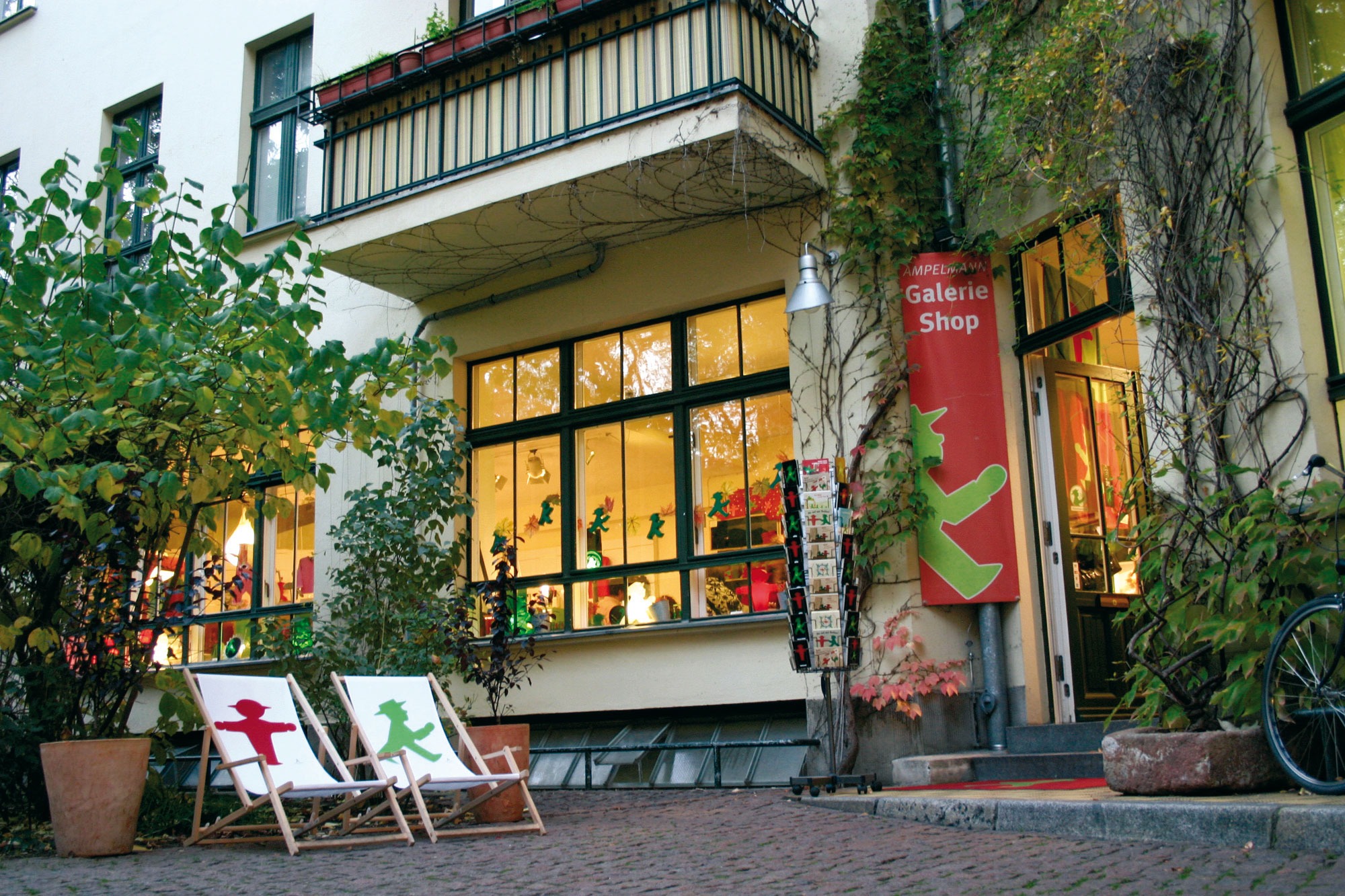The Ampelmann – at home in the Hackesche Höfe

The Ampelmännchen is a reminder of the demise of the GDR and Germany’s reunification. The company Ampelmann celebrates the man with the hat with ever-new products. Only a few people know that it all began in the Hackesche Höfe.
Symbolic figure
The division of Berlin and the collapsed East German state still fascinate people today. Almost nothing has remained of it – except the traffic light man. Committed citizens, including the West German product designer Markus Heckhausen, campaigned to save him in the 1990s – successfully. The traffic light man is still on the road for the safety of pedestrians. He has become a symbolic figure for a reunified Germany. And Heckhausen found his task in life: He turned the traffic light man into a cult brand.

A star was born
The traffic light man first saw the light of day shortly after the construction of the Berlin Wall in what was then East Berlin. His "father" was the traffic psychologist Karl Peglau. In October 1961, he submitted proposals for new traffic light symbols. They were supposed to protect pedestrians from accidents. Until then, they could only orientate themselves by the colors of the traffic lights – a problem for people with red-green deficiency. It took until 1969 for Peglau's new traffic light man to be used for the first time at a prominent location – he was flashing in Berlin at the Unter den Linden/Friedrichstraße intersection.
Photo: Karl Peglau 1996. An early version of his Ampelmännchen still had fingers.


The Eastern traffic light men are better
Unlike his Western pictogram colleagues, Peglau's traffic light man has a face and hands, wears a hat and clearly shows what's what: When the light is green, he strides forward briskly; when it's red, he spreads his arms. He is also much chubbier. The hat and the greater corpulence not only make him human and likable, but also help him in his job: More surface area means more light, i.e. better visibility – and thus more safety for pedestrians.
Image: Eastern and western traffic light man

The winding-up
After the fall of communism and reunification, many companies and institutions of the defunct GDR were liquidated. A country vanished. The obsolete traffic lights were also dismantled and replaced by new ones – with the West German traffic light man.
Markus Heckhausen, a designer from Tübingen, comes to Berlin at the end of the 1980s. He is interested in remnants from the GDR. "Everything that referred to life in the GDR was exciting for us," he says. "We collected these things, recycled them, made something new out of them," Heckhausen recalls. When he observed another traffic light being dismantled at Rosenthaler Platz, Heckhausen secured the traffic light glass. And used it to build the first Ampelmann product: a traffic light lamp.
Photos: Markus Heckhausen working on his traffic light lamps and striking the “Ampelmann” pose
Photo below: The lamp’s first presentation during a gallery tour in Auguststraße

The rescue
In 1996 Heckhausen contacted Karl Peglau, the inventor of the traffic light man. Peglau invited him to have coffee in his Pankow flat. It was the beginning of a friendly collaboration until Peglau's death in 2009. Heckhausen reappraised the history of the East traffic light man in a book project with Peglau's support.
The book attracts attention, and a committee is formed to save the traffic light man. For many, the traffic light man becomes a symbol for the loss of home, for the "liquidation" of everything that defined the GDR. The term "Ostalgie" is coined to describe this feeling. The traffic light man campaign is successful. As a first step, Berlin's traffic senator stops the dismantling of pedestrian traffic lights, and other East German states follow suit. The traffic light man is saved.
Photo left: 2001: pop-up store with the first products in courtyard 3 of the Hackesche Höfe
Photo right: the Ampelmann store shortly after opening

The brand
Markus Heckhausen uses the cult status to build a brand. On the occasion of the Ampelmännchen’s 40th birthday, he opens a pop-up store in the former Trafohaus in Hof 3 of the Hackesche Höfe. There he presents his first 20 products. Shortly afterwards, the first Ampelmann shop opens in courtyard 5 of the Hackesche Höfe. In the beginning, this also housed the headquarters of the young company with the office and a warehouse in the basement. The shop is still there today. Markus Heckhausen: "The playground, the big tree, the view of the greenery – it's unique. I always wanted to stay in this very courtyard."
More Ampelmann branches at tourist hot spots followed: Visitors to Berlin may arrive at the main railway station or at BER airport, they may visit the Ku'damm, the Linden or the Gendarmenmarkt: The traffic light man is everywhere. The more than 500 products featuring the cult figure have become THE souvenir from the capital. Even the Berlin bear can't keep up with that.
In the course of equalization, the company has now given the traffic light man a traffic light woman with a little dress and pigtails. But she has not yet been able to conquer the traffic lights. For the time being, these remain among the last male domains.
Video: Markus Heckhause tells the story of the Ampelmann store in the Hackesche Höfe
Hackesche Höfe, Hof 5, Rosenthaler Straße 40-41
Unter den Linden 35
In DomAquarée, Karl-Liebknecht-Straße 5
At Gendarmenmarkt, Markgrafenstraße 37
In the Kranzler-Eck, Kurfürstendamm 20
Central Station ground floor, Europaplatz 1
BER Airport, Terminal 1
You’ll find more info here.
